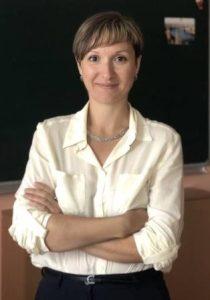Воспитание у учащихся чувства патриотизма, развитие и углубление знаний об истории и культуре родного края, развитие коммуникативной и социокультурной компетенции учащихся через изучение историко-культурного наследия.
 Людмила СИДОРЕНКО,
Людмила СИДОРЕНКО,
учитель английского языка,
ГУО «Средняя школа № 41 имени А.М.Кузнецова г. Гродно»
Гродно – одно из старейших поселений Беларуси. Его история уходит вглубь веков. Архитектура города всегда была богатой, разнообразной и неповторимой. В ней нашли отражение такие стили, как ренессанс, барокко, псевдорусский и готический стили. Итальянские, немецкие, польские и русские архитекторы оставили свой след в Гродно, но из-за большого количества войн, пожаров и перестроек архитектурные памятники были изменены.
В Беларуси было около 150 замков, много церквей, синагог. Большинство из них были утрачены, и на их месте уже стоят новые здания. Изучение утраченных памятников – это неотъемлемая часть нашей истории, которую должны знать подростки.
В наши дни, когда Гродно является туристическим безвизовым центром, знание истории нашего города может помочь учащимся наладить общение с представителями других стран. Рассказывая туристам историю Гродно, тем самым развивая коммуникативную и социокультурную компетентность в изучении иностранного языка, воспитывая чувство патриотизма и любви к родному краю.
Актуальность занятия
Изучение утраченных памятников истории и архитектуры способствуют духовно-нравственному воспитанию учащихся, формированию их мировоззрения, формированию ценностных ориентаций, служащих основой активной жизненной позиции будущего гражданина, способствует развитию патриотизма.
Цель занятия:
воспитание у учащихся чувства патриотизма, развитие и углубление знаний об истории и культуре родного края, развитие коммуникативной и социокультурной компетенции учащихся через изучение историко-культурного наследия Гродно.
Historical places of Grodno
Materials and equipment:
-
- a multi board;
- internet resources;
- interactive poster «Lost architectural monuments оf Grodno»;
- students’ mobile phones;
- supplement materials – photocopies;
- annex

QR-code for interactive poster
The aim of the lesson:
at the end of the lesson students will be able to express their opinion and answer the key question of the lesson “Is it important to know the history of our country, to know the history of architectural monuments of the past? Why?”
Students will
be able to speak about Lost architectural monuments оf Grodno
Lesson plan
Stage of the lesson: preliminaries (5 min)
To warm up, to create the atmosphere of foreign language; to provide positive motivation for learning English
Teacher’s activity
Greetings
Grodno is one of the oldest settlements in Belarus. It history goes back centuries. The settlement “Goroden” was first mentioned under the year 1127 in the Radziwill and Laurentian chronicles. During its long history Grodno was a part of many States: the Grand Duchy of Lithuania, the Polish-Lithuanian Commonwealth, the Russian Empire, the USSR.
Each of these periods left its own unique mark in the history and architecture of the city. The city experienced periods of the highest prosperity (it was the residence of the kings of the Polish-Lithuanian Commonwealth) and decline (with the inclusion of the city into the Russian Empire).
The architecture of the city has always been rich, diverse and unique. Italian, German, Polish and Russian architects left their marks in Grodno but due to the large number of wars, fires and reconstructions architectural monuments have been changed or have been lost.
Can you answer my questions:
Are you interested in the history of our city?
Have you ever visited any historical places of our city?
Name some cultural and historical monuments of Grodno.
Look at the screen and using your mobile phones and Menti.com
Mark historical monuments of Grodno which are familiar to you.
- Tiesengauz Palace
- Sapieha Palace
- City Hall
- Prechistenskaya Church
- The Church of the Holy Cross
- The Dominican Church
- The Bernardine monastery
- The Carmelite church
- Alexander Nevsky Church
- Farah Vitovta
Would you like to learn more about the lost cultural monuments?
Pupils’ activity
Pupils answer the questions Interaction model: T – P1-P2-P3…
Main part of the lesson
To claim aims
Today we are going to speak about the history of our native city, its lost architectural monuments, learn some new words and I hope that at the end of our lesson you will be able to answer the question “Is it important to know the historical places of our city, our country, to know the history of architectural monuments of the past? Why?”
Stage of the lesson: revise the vocabulary (4 min)
To stimulate abilities for self-study and self-check
Teacher’s activity
Let’s revise the active vocabulary of our lesson. Use your mobile phones and online Cambridge Dictionary. Look at the definitions and guess the words.
Pupils’ activity. Pupils work independently.
Interaction model: P1 – Cl, P2 – Cl…
Active vocabulary of the lesson
nativity/ dissemble/ embankment/ consecrated/ premises/ dismantle/ brewery/ virgin/ decline/ nobility/ iconostasis/ reconstruction/ vaults/ erect
Give the definitions of the words
Stage of the lesson: revise grammar material Passive Voice/ pre-reading task (7 min)
Teacher’s activity
Look through the sentences and explain the formation of the Past Simple Passive.
Pupils’ activity.
Interaction model: T – Cl
- By order of King Stefan Batory a stone church in the Renaissance style was erected there.
- The brewery was destroyed by fires.
- The premises were used as warehouses, a cinema, a physical education house.
Put the verbs in brackets in the form of Past Simple Passive.
- The church (to found) by Mstislav Frederik Sapieha.
- In the 1870s the Dominican Church in modern Sovetskaya Street (to dismantle).
- The first wooden church of the Carmelites (mark) on the plans of Grodno in 1655 and 1706.
- The monastery walls (to transfer) to the military department in 1843.
- In the early 1990s the symbolic facade of the temple (to restore).
- The temple and the monastery cemetery located in the courtyard (to surround) by walls.
- Many additional premises (to build) on the territory which later belonged to the Shereshevsky tobacco factory.
- In April 1870 the church (to consecrate).
- In 1906-1907 its reconstruction (to carry out): a large vestibule (to add) to the west side, several new domes (to erect), the facad (to decorate) with stucco decoration.
- During the First World War the roof of the church (to dismantle).
- Representatives of the local nobility (to bury) in the vaults of the church.
Change sentences from Active into Passive Voice.
- The Carmelites used the church to conduct their services there.
- They began construction of a new stone church and a monastery.
- The monastery received donations from patrons and gradually expanded its possessions.
- Jerome Volovich founded the Bernardine monastery.
- In 1964 the city authorities decided to build a drama theater on the site of the former church and the monastery.
- Alexander II visited the Church on June 24.
- The owners changed Sapieha Palace several times.
- Antony Tizengauz built a new district of the city in the former royal village Gorodnitsa.
Stage of the lesson: reading activity (4min)
Teacher’s activity. (Before the lesson teacher choose 4 texts for discussion and print them on paper of different colours) Teacher distributes the tasks to the students. Give them photocopies with the questions. (Annex 1)
While reading the texts students find the answers to the questions and make some notes. What’s the name of the monument? When was it founded? Who was it founded by? Why was the monument important place? When was it destroyed and why?
Pupils’ activity. Pupils read the texts individually. Find the answers to the questions/ make
Interaction model: T – P1/T – P2…
Stage of the lesson: work in groups/ To develop speaking skills. (10 min)
To change activities.
Teacher’s activity
After reading the texts pupils should split into groups according to the colours of their cards (three groups by 4 pupils. Each of them has read different texts). To share and describe the information in groups/ after describing speak about the monuments of the past)
Interaction model: P – P
Interaction model: P – CL
Teacher’s activity/ ask the question
If you had the opportunity to visit any monuments of the past which of them would you like to choose? And Why?
Pupils’ activity. Answer the questions.
Using the map of Grodno find the following monuments of the past and speak about their location. (Annex 2)
Tiesengauz Palace, Sapieha Palace, City Hall, Prechistenskaya Church, The Church of the Holy Cross, The Dominican Church, The Bernardine monastery, The Carmelite church Alexander Nevsky Church, Vitovta’s Church
Where were they situated?
Use the words for help (in the center, in front of, opposite, behind, to the left of the, to the right of the, between, near, next to, etc.)
Stage of the lesson: work in pairs. (6 min)
To develop speaking skills. Dialogue speech
Use the map and help a tourist to find his (her) way from… to… .
Use the words for help (First, then, go along, go past, turn left, turn right, go straight ahead, go over, at the traffic lights, etc)
Make up a dialogue between a tourist and a citizen of Grodno.
(Use the information of our work and additional information from the internet)
Questions for help:
Sorry, can you help me? How can I get to…?
Where was … situated?
When was it built?
Who was the architect of the monument?
When and why was it destroyed?
What was it used for?
Students express their opinion and answer the key question of the lesson (4 min)
“Is it important to know the historical places of our country, to know the history of architectural monuments of the past? Why?”
Stage of the lesson: assigning home task (1 min)
Teacher’s activity. Explain home task
Using the information of the interactive poster, make a presentation and speak about 1 historical monument of Grodno from the list.
Pupils’ activity. Pupils put down their task in the record books.
Interaction model: T– Cl
Stage of the lesson: reflection (3 min)
Use menti.com Answer the question
Continue the phrase «History helps …» (pupils can use the word combinations or short sentences to answer the questions)
Pupils answer the questions
Teacher’s activity
To sum up the information
History helps to understand our own culture and development of our country; love and appreciate our city and country; it allows us to understand our past which in turn allows us to understand our present; history helps to learn from the mistakes of the past; to preserve and transmit our values and traditions; to share your knowledge with tourists.
Stage of the lesson: assessment (2 min)
To assess and motivate pupils
Поделиться ссылкой:
- ВКонтакте
- РћРТвЂВВВВВВВВнокласснРСвЂВВВВВВВВРєРСвЂВВВВВВВВ
- Viber
- Skype
- Telegram



 Предложить публикацию
Предложить публикацию